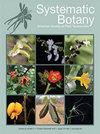A Generic Taxonomic Synopsis of the Pleurophyllum Clade (Asteraceae: Astereae: Celmisiinae) with the Recognition of the New Zealand Endemic New Genus Macrolearia
IF 0.8
3区 生物学
Q4 EVOLUTIONARY BIOLOGY
引用次数: 0
Abstract
Abstract The Pleurophyllum clade is one of two main clades within subtribe Celmisiinae (Astereae) and includes 10 species almost entirely restricted to New Zealand (one species also occurs in the Australian Macquarie Islands), with seven of them confined to Stewart Island/ Rakiura and the outlying Chatham and subantarctic islands. The clade is defined by its purple to dark red cyathiform disc corollas, which are absent from the other members of Celmisiinae. A new generic taxonomy of the clade is presented here with the recognition of three genera: Pleurophyllum with three species, Damnamenia (monotypic), and Macrolearia, a new genus segregated from Olearia, which is described here to accommodate the six species and one hybrid previously known as the “macrocephalous olearias.” The main morphological differences between the three genera lie in the growth form, trichome types of leaves and disc corollas, morphology of the style branches, presence/ absence of staminodes, and cypselae morphology. These morphological differences are also discussed within subtribe, tribe, and family contexts, and special consideration is given to the use of the “megaherb growth form” concept for Pleurophyllum. The allopatric distribution of the three recognized genera is also stressed. Seven new combinations: Macrolearia angustifolia, Macrolearia oporina, Macrolearia semidentata, Macrolearia chathamica, Macrolearia colensoi, Macrolearia lyallii, and Macrolearia × traillii, and five new synonyms are proposed, and four names are lectotypified. Taxonomic keys are provided for genera and species.胸膜菌分支的属分类概要(菊科:Astereae:Celmisiinae)与新西兰特有新属Macroleria的识别
白蛉门(Pleurophyllum)是白蛉亚科(Astereae)中两个主要分支之一,包括10种几乎完全局限于新西兰的白蛉(1种也分布于澳大利亚麦夸里群岛),其中7种分布于斯图尔特岛/拉基拉岛以及外围的查塔姆岛和亚南极岛。这个分支的特征是紫色到暗红色的圆锥形花冠,这在其他的蛇麻科成员中是不存在的。本文提出了该分支的一个新的属分类,并承认了三个属:Pleurophyllum(三种),Damnamenia(单型)和Macrolearia(从Olearia中分离出来的一个新属),这里描述的是为了适应六个物种和一个以前被称为“macrocephalous olearias”的杂种。三属植物的主要形态差异在于生长形态、叶片和花冠的毛状体类型、花柱分枝的形态、雄蕊的有无和聚穗的形态。这些形态差异也在亚部落、部落和家庭背景下进行了讨论,并特别考虑了胸叶属“巨型草本植物生长形式”概念的使用。文中还强调了这三个属的异源分布。提出了7个新组合:粗叶大learia angustifolia、粗叶大learia oporina、半长叶大learia semiidentata、chathamica大learia colensoi、lyalliia lyallii、Macrolearia x traillii和5个新同义词,并对4个名称进行了选型。提供了属和种的分类键。
本文章由计算机程序翻译,如有差异,请以英文原文为准。
求助全文
约1分钟内获得全文
求助全文
来源期刊

Systematic Botany
生物-进化生物学
CiteScore
1.80
自引率
10.00%
发文量
72
审稿时长
6-12 weeks
期刊介绍:
Systematic Botany Monographs is a series of peer-reviewed taxonomic monographs and revisions published the American Society of Plant Taxonomists. ISSN 0737-8211, ISBN prefix 978-0-912861. No; volumes of Systematic Botany Monographs must be ordered separately. ASPT membership inludes only a subscription to the quarterly journal Systematic Botany. SBM is supported by sales, author"s subsidies, and donations.
 求助内容:
求助内容: 应助结果提醒方式:
应助结果提醒方式:


